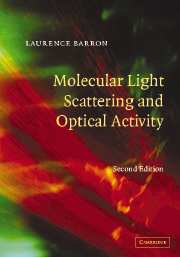Book contents
- Frontmatter
- Contents
- Preface to the first edition
- Preface to the second edition
- List of symbols
- 1 A historical review of optical activity phenomena
- 2 Molecules in electric and magnetic fields
- 3 Molecular scattering of polarized light
- 4 Symmetry and optical activity
- 5 Natural electronic optical activity
- 6 Magnetic electronic optical activity
- 7 Natural vibrational optical activity
- 8 Antisymmetric scattering and magnetic Raman optical activity
- References
- Index
6 - Magnetic electronic optical activity
Published online by Cambridge University Press: 07 August 2009
- Frontmatter
- Contents
- Preface to the first edition
- Preface to the second edition
- List of symbols
- 1 A historical review of optical activity phenomena
- 2 Molecules in electric and magnetic fields
- 3 Molecular scattering of polarized light
- 4 Symmetry and optical activity
- 5 Natural electronic optical activity
- 6 Magnetic electronic optical activity
- 7 Natural vibrational optical activity
- 8 Antisymmetric scattering and magnetic Raman optical activity
- References
- Index
Summary
I have succeeded in magnetizing and electrifying a ray of light, and in illuminating a magnetic line.
(Michael Faraday)Introduction
This chapter is concerned mainly with the visible and near ultraviolet optical rotation and circular dichroism that all molecules show in a static magnetic field. Magnetic optical activity is generated by appropriate components of α′αβ, the imaginary part of the complex dynamic polarizability tensor. As discussed in Chapter 4, α′αβ is time odd and can only contribute to birefringence phenomena in the presence of some external time-odd influence. This chapter deals mainly with a liquid or solution sample in a static magnetic field, which constitutes a uniaxial medium for light propagating along the field direction.
The formulation of magnetic optical rotation and circular dichroism developed below is based on an article by Buckingham and Stephens (1966), which is itself based on Stephen's dissertation (1964). Although the correct quantum mechanical description had been given much earlier by Serber (1932), it was the Buckingham–Stephens work that initiated a new era in magnetic optical activity, at least in chemistry.
Since magnetochiral birefringence and dichroism are generated by appropriate components of the time-odd molecular property tensors Gαβ and A′α, βγ in a static magnetic field collinear with the propagation direction of the light beam in a manner analogous to the generation of magnetic optical activity through α′ αβ, a quantum mechanical theory of these effects is also developed in this chapter.
- Type
- Chapter
- Information
- Molecular Light Scattering and Optical Activity , pp. 311 - 330Publisher: Cambridge University PressPrint publication year: 2004

